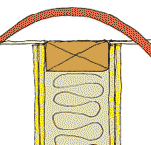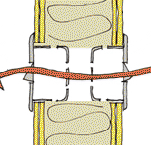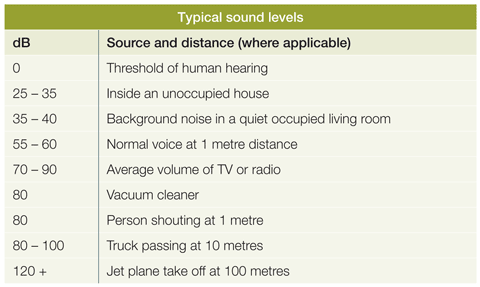- Home
- Site Analysis
- Site Use
- Passive Design
- Water
- Material Use
- Energy
- Wet Areas
- Health and Safety
- Other Resources
Passive Design
Designing the building and the spaces within it to benefit from natural light, ventilation and even temperatures.
Noise: basic concepts
An understanding of how sound travels and reverberates can help designers to minimise noise in the building.
On this page:
- sound perception
- sound paths
- reverberation
- measuring sound transmission.
Noise is pressure waves transmitted through the air. Sound pressure is measured in decibels (dB). The range of human hearing is from about 0 dB, the threshold of our hearing, to 140 dB, which is above the threshold of pain.
Sound perception
Sound perception is individual i.e. some people enjoy music at levels that other people find painful and annoying.
For every increase of 3 dB, the sound energy is approximately doubled, so a 5 dB increase in sound is readily noticeable – 10 dB is 10 times more powerful than 0 dB, 20 dB is 100 times more powerful than 0 dB, 30 dB is 1,000 times more powerful than 0 dB, and so on.
Sound pressure decreases as distance from the source increases.
High frequency noise is considered more harmful to hearing than low frequency noise, but it is more difficult to reduce the impact of low frequency noise such as from a bass guitar or traffic.
Sound paths
Sound can reach the receiver by:
- following a direct path from the source
- being deflected off one or more surfaces
- passing over or around obstructions or through small gaps
- travelling through solid materials such as the building elements.
Sound is able to pass through gaps and cracks, which means that any break in a sound barrier will reduce its effectiveness. Examples include gaps around doors, keyholes, ceiling spaces above walls, gaps or cracks around partitions, windows that do not seal well, degraded seals around glazing panes, power outlets, light switches and pipework penetrations. All of the ways in which sound can enter a space must be considered.
Sound is dampened by passing through materials of high mass, therefore lightweight materials (such as lightweight doors) do not dampen sound as much as heavy materials, such as solid doors.

- Sound loss through the ceiling space
Sound is blocked by the acoustic-insulated wall but passes through an open ceiling space.

- Sound paths through electrical fittings
Sound will travel through any break in an acoustic system such as back-to-back power outlets. This will reduce the effectiveness of the acoustic system.
Reverberation
Reverberation is the sound that continues to reflect off surfaces after the noise has stopped at source. Reverberation time is the time that sound continues to be reflected. A long reverberation time (three seconds or more) will mask the original sound and become background noise that makes conversation difficult.
Sound reverberates from hard surfaces such as walls and hard floors, whereas soft surfaces such as carpets, curtains and soft furnishings absorb sound instead of reflecting it. A room with a lot of sound-absorbent material will seem to be quieter than a room with hard surfaces.
Measuring sound transmission
The amount of noise that a building element (such as a wall, floor, door or sheet of glass) is capable of stopping is expressed as a sound transmission class (STC) rating. The higher the STC number, the greater the noise reduction. For example, a wall with an STC rating of:
- 30 dB has little sound-control effectiveness
- 35 dB allows normal conversation to be heard through the wall
- 40 dB allows loud conversation to be heard through the wall
- 50 dB will prevent loud conversation from being heard through the wall.
Under NZBC clause G6 Airborne and impact sound, 55 dB is the inter-tenancy wall STC rating requirement.
Other sound transmission ratings are:


